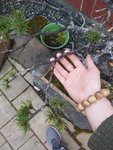I've come to a wall in my understanding of how, in the long run, to have a branch with compact foliage. By compact foliage I don't mean ramification, per say. I'm referring to having foliage on a branch that is closer to the trunk of the tree as opposed to growth near the tips of branches.
I understand the principal of ramification. Cut at back buds and reduce to two. Rinse and repeat.
This should apply to all my pines (maybe all trees in general?), but to hone in on my personal dilemma: I have a few older yamadori shore pines. Take one in particular that is approx. 100 year old. Its in good health and has been off the mountain and in a training pot for 5 years. It's lower branches are about ten inches long which display very healthy foliage at the tips of secondary and tertiary branches. There are back buds, but they are all clustered within a few centimetres to a couple inches of the growing areas.
From what I've researched it is likely to get back buds further back on the branch; however, I've been told to not expect back budding on wood that is over 6-ish years old. Well these primary and secondary branches could easily be 10+ years old. In any case, if I reduce foliage steadily, the back buds will only form so far away from the growing tip. And the longer this gradual process takes, the older the primary and secondary branches become. It seems like its a case of diminishing pace between the limit of aging branches and stubborn back budding.
I can guess that a centenarian pine might be a harder case, but this should apply to any pine branch that is 10 years and older, no?
Isn't it so that as a pine outgrows it's desired silhouette, that's when we cut off terminal growth and allow the back buds to take their place, right? But how can this process continue, for even a decade, as the primary and secondary branches age and "wood up"?
Additionally, has anyone ever heard of removing scaly bark as to allow cambium a shot at back budding?



